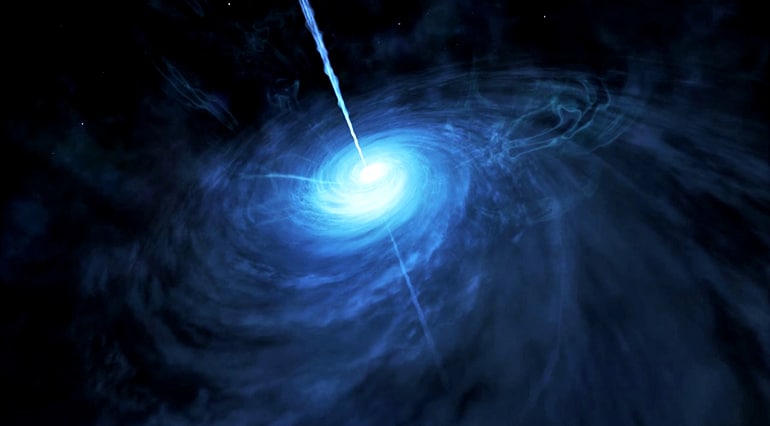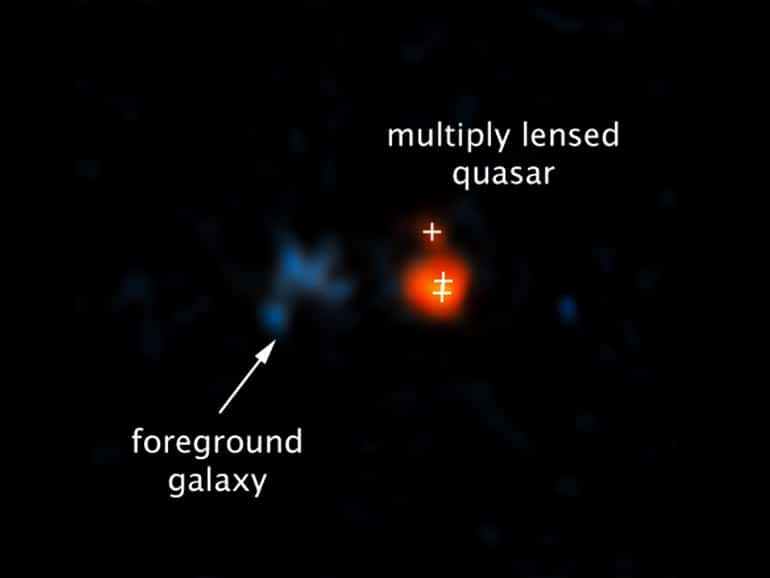
.
Good news on the Quaser front. what has been observed is a young event that has also been lensed and allows us to see back into the earliest times after creation.
What this means is that the precipitating matter is still insufficient to block visibility. Recall that it is my conjecture that the event horizon of a black hole unravels matter into complex photonic radiation that exits the horizon at light speed carrying matter making information with it. Decay later produces matter.
Lensing effects are also now been seen too often for any comfort..
Quasar shines with light of 600 trillion suns
January 11th, 2019 Posted by Daniel Stolt
https://www.futurity.org/quasar-early-universe-1955022/
Astronomers have discovered the brightest object ever seen at a time when the universe was less than one billion years old.
The brilliant beacon is a quasar, the core of a galaxy with a black hole ravenously eating material surrounding it.
Though the quasar is very far away—12.8 billion light-years—astronomers can detect it because a galaxy closer to Earth acts as a lens and makes the quasar look extra bright. The gravitational field of the closer galaxy warps space itself, bending and amplifying the distant quasar’s light in an effect known as gravitational lensing.
Off the charts
Researchers have searched for extremely remote quasars for more than 20 years before a rare and fortuitous celestial alignment made this one visible. The super-bright quasar, which researchers discovered with the University of Arizona’s MMT Telescope, could hold the record for the brightest in the early universe.
“We don’t expect to find many quasars brighter than that in the whole observable universe,” says lead investigator Xiaohui Fan, professor of astronomy at the University of Arizona’s Steward Observatory.

This artist’s impression shows how J043947.08+163415.7, a very distant quasar powered by a supermassive black hole, may look close up. This object is by far the brightest quasar yet discovered in the early universe. (Credit: ESA/Hubble, NASA, M. Kornmesser) Shining with light equivalent to almost 600 trillion suns, a supermassive black hole at the heart of a young galaxy in the process of forming fuels the quasar. As the black hole consumes material around it, it emits an immense amount of energy.
The detection provides a rare opportunity to study a zoomed-in image of how such black holes accompanied star formation in the very early universe and influenced galaxy assembly.
“If this quasar was not lensed, its brightness would have been more than 50 times ‘fainter,'” Fan says. This one is off-the-charts bright.”
The detection provides a rare opportunity to study a zoomed-in image of how such black holes accompanied star formation in the very early universe and influenced galaxy assembly.
“If this quasar was not lensed, its brightness would have been more than 50 times ‘fainter,'” Fan says. This one is off-the-charts bright.”
Magnified view
Researchers used the Large Binocular Telescope to get the first images suggesting a possible lensing structure.
The lensed quasar is not only bright in visible and infrared wavelengths, but also bright in submillimeter wavelengths. That emission is due to dust that intense star formation in the galaxy hosting the lensed quasar heats. The formation rate is up to 10,000 stars per year, the researchers estimate. In comparison, our Milky Way galaxy makes one star per year.
“Clearly, this black hole is not only accreting gas, but it also has a lot of star formation around it,” says team member Jinyi Yang. “However, because of the boosting effect of gravitational lensing, the actual rate of star formation could be much lower than the observed brightness suggests.”

A Hubble Space Telescope image of a very distant quasar (at right) that has been brightened and split into three images by the effects of the gravitational field of a foreground galaxy (left). (Image: NASA, ESA, Xiaohui Fan/U. Arizona) The quasar existed at a transitional period in the universe’s evolution called reionization, where light from young galaxies and quasars reheated the obscuring hydrogen that cooled off not long after the big bang.
Researchers wouldn’t have detected the quasar if not for the power of gravitational lensing, which boosted its brightness by a factor of 50.
“Essentially, we have a very magnified view of this supermassive black hole,” Fan says. “It’s like a magnifying glass that gives you an image that’s not just brighter, but also bigger. We now can look at the much smaller structures surrounding that black hole.”
Researchers identify very distant quasars by their red color (due to absorption by diffuse gas in intergalactic space), although sometimes their light is “contaminated” and looks bluer because of the starlight of an intervening galaxy. As a result, researchers may overlook them in quasar searches because their diluted color resembles that of a normal galaxy.
“We think there probably are 10 to 20 of such objects that we haven’t found because they would have looked fuzzy and the colors not redshifted enough,” Fan says. “This by extension means that our traditional way of finding quasars may not work anymore, and we have to find some new, big data approach to broaden our search.”
Researchers wouldn’t have detected the quasar if not for the power of gravitational lensing, which boosted its brightness by a factor of 50.
“Essentially, we have a very magnified view of this supermassive black hole,” Fan says. “It’s like a magnifying glass that gives you an image that’s not just brighter, but also bigger. We now can look at the much smaller structures surrounding that black hole.”
Researchers identify very distant quasars by their red color (due to absorption by diffuse gas in intergalactic space), although sometimes their light is “contaminated” and looks bluer because of the starlight of an intervening galaxy. As a result, researchers may overlook them in quasar searches because their diluted color resembles that of a normal galaxy.
“We think there probably are 10 to 20 of such objects that we haven’t found because they would have looked fuzzy and the colors not redshifted enough,” Fan says. “This by extension means that our traditional way of finding quasars may not work anymore, and we have to find some new, big data approach to broaden our search.”
Lucky break
The team got lucky with finding the quasar, dubbed J043947.08+163415.7, Fan says. Since it’s so bright, it drowns out the especially faint foreground lensing galaxy’s starlight.
“Without this high level of magnification, it would make it impossible for us to see the galaxy,” says team member Feige Wang of the University of California, Santa Barbara. “We can even look for gas around the black hole and what the black hole may be influencing in the galaxy.”
Researchers conducted Follow-up spectroscopic observations using the Multi-Mirror Telescope, the Gemini Observatory, and the Keck Observatory. These observations revealed the signature of a faint foreground galaxy directly between the quasar and Earth that is magnifying the quasar image. However, because the source looks fuzzy in the ground-based observations (and so could be mistaken for only a galaxy), the researchers used Hubble’s imaging capabilities to confirm it is a lensed quasar.
“It’s a hard system to photograph because it turns out to be so compact, which requires the sharpest view from Hubble,” Fan says.
The quasar is ripe for future scrutiny. Fan’s team is analyzing a detailed 20-hour spectrum from the European Southern Observatory’s Very Large Telescope, which would show gas absorption features to identify chemical composition and temperatures of intergalactic gas in the early universe. Astronomers also will use the Atacama Large Millimeter/submillimeter Array, and eventually NASA’s James Webb Space Telescope, to look within 150 light-years of the black hole to directly detect the influence of the black hole’s gravity on gas motion and star formation in its vicinity.
The findings appear in the Astrophysical Journal. The team also presented the discovery during a press briefing at the 233rd Meeting of the American Astronomical Society in Seattle.
Source: University of Arizona
Original Study DOI: 10.3847/2041-8213/aaeffe
No comments:
Post a Comment